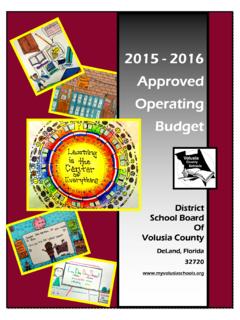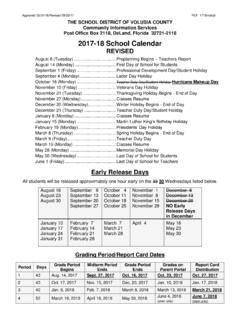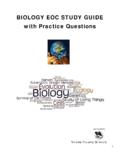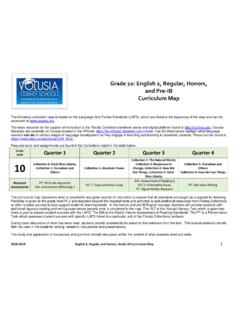Transcription of Earth – Space Science - Volusia County Schools
1 2017 - 2018 Earth Space Science Curriculum Map Volusia County Schools Created For Teachers By Teachers Curriculum Mapping Committee: Chris Broomall Brad McFarland Nathan Murphy Nicholas Pieri David Rivera Charlea Hinton-Manson David Collins Regular and Honors 2017-2018 Volusia County Schools Earth Space Curriculum Map Page 2 Parts of the Curriculum Map The curriculum map defines the curriculum for each course taught in Volusia County . They have been created by teachers from Volusia Schools on curriculum mapping and assessment committees. The following list describes the various parts of each curriculum map: Units: the broadest organizational structure used to group content and concepts within the curriculum map created by teacher committees. Topics: a grouping of standards and skills that form a subset of a unit created by teacher committees. Learning Targets and Skills: the content knowledge, processes, and skills that will ensure successful mastery of the NGSSS as unpacked by teacher committees according to appropriate cognitive complexities.
2 Standards: the Next Generation Sunshine State Standards (NGSSS) required by course descriptions posted on CPALMS by FLDOE. Pacing: recommended time frames created by teacher committees and teacher survey data within which the course should be taught in preparation for the EOC. Academic Language: the content-specific vocabulary or phrases both teachers and students should use, and be familiar with, during instruction and assessment. Maps may also contain other helpful information, such as: Resources: a listing of available, high quality and appropriate materials (strategies, lessons, textbooks, videos and other media sources) that are aligned to the standards. These resources can be accessed through the County Earth and Space Canvas. Contact the District Science Office if you are having difficulty accessing Canvas. Teacher Hints: a listing of considerations when planning instruction, including guidelines to content that is inside and outside the realm of the course descriptions on CPALMS in terms of state assessments.
3 Sample FOCUS Questions: sample questions aligned to the standards and in accordance with EOC style, rigor, and complexity guidelines; they do NOT represent all the content that should be taught, but merely a sampling of it. Labs: The NSTA and the District Science Office recommend that all students experience and participate in at least one hands-on, inquiry-based, lab per week were students are collecting data and drawing conclusions. The district also requires that at least one (1) lab per grading period should have a written lab report with analysis and conclusion. Common Labs (CL): Each grade level has one Common Lab (CL) for each nine week period. These common labs have been designed by teachers to allow common Science experiences that align to the curriculum across the district. Science Literacy Connections (SLC): Each grade level has one common Science Literacy Connection (Common SLC) for each nine week period. These literacy experiences have been designed by teachers to provide complex text analysis that aligns to the curriculum across the district.
4 Additional SLCs are provided to supplement district textbooks and can be found on the Canvas. DIA: (District Interim Assessments) content-specific tests developed by the district and teacher committees to assist in student progress monitoring. The goal is to prepare students for the 8th grade SSA or Biology EOC using rigorous items developed using the FLDOE Item Specifications Documents. The last few pages of the map form the appendix that includes information about methods of instruction, cognitive complexities, and other Florida-specific standards that may be in the course descriptions. Appendix Contents 1. Volusia County Science 5E Instructional Model 2. FLDOE Cognitive Complexity Information 3. Florida ELA and Math Standards 2017-2018 Volusia County Schools Earth Space Curriculum Map Page 3 2017-2018 Instructional Calendar Week Dates Days Quarter Week Dates Days Quarter 1 2 3 4 5 6 7 8 9 14 August - 18 August 21 August - 25 August 28 August - 1 September 5 September - 8 September 11 September - 15 September 18 September - 22 September 25 September - 29 September 2 October - 6 October 9 October - 13 October 5 5 5 4 5 5 5 5 5 1st Quarter (9 weeks) 20 21 22 23 24 25 26 27 28 8 January 12 January 16 January 19 January 22 January 26 January 29 January 2 February 5 February 9 February 12 February 16 February 20 February 23 February 26 February 2 March 5 March 8 March 5 4 5 5 5 5 4 5 4 3rd Quarter (9 weeks)
5 10 11 12 13 14 15 16 17 18 19 17 October - 20 October 23 October 27 October 30 October - 3 November 6 November - 9 November 13 November - 17 November 20 November - 21 November 27 November - 1 December 4 December - 8 December 11 December - 15 December 18 December 20 December 4 5 5 4 5 2 5 5 5 3 2nd Quarter (10 weeks) 29 30 31 32 33 34 35 36 37 19 March 23 March 26 March 30 March 2 April 6 April 9 April 13 April 16 April 20 April 23 April 27 April 30 April 4 May 7 May 11 May 14 May 18 May Start Review and Administer EOC* 5 5 5 5 5 5 5 5 5 4th Quarter (11 weeks) *See school -based testing schedule for the course EOC administration time 38 39 21 May 25 May 29 May 30 May 5 2 Lab Information Expectations: The National Science Teacher Association, NSTA, and the district Science office recommend that all students experience and participate in at least one hands-on-based lab per week. At least one (1) lab per grading period should have a written lab report with analysis and conclusion.
6 Safety Contract: Safety, Cleanup, and Laws: 2017-2018 Volusia County Schools Earth Space Curriculum Map Page 4 2017-18 Full Instructional Calendar August 2017 Sun Mon Tue Wed Thu Fri Sat 1 2 3 4 5 6 7 8 Preplan begins 9 10 11 12 13 W1 14 1st day of school 15 16 ER 17 18 19 20 W2 21 Solar Eclipse 22 23 ER 24 25 26 27 W3 28 29 30 ER 31 September 2017 Sun Mon Tue Wed Thu Fri Sat 1 District PD Day 2 3 W4 4 Labor Day 5 6 ER 7 8 9 10 W5 11 12 13 ER 14 15 16 17 W6 18 19 20 ER 21 22 23 24 W7 25 26 27 ER 28 29 30 October 2017 Sun Mon Tue Wed Thu Fri Sat 1 W8 2 3 4 ER 5 6 7 8 W9 9 10 11 ER 12 13 End 1st qtr 14 15 W10 16 Teacher Duty Day 17 18 ER 19 20 21 22 W11 23 24 25 ER 26 27 28 29 W12 30 31 November 2017 Sun Mon Tue Wed Thu Fri Sat 1 ER 2 3 4 5 W13 6 7 8 ER 9 10 Veterans Day 11 12 W14 13 14 15 ER 16 17
7 18 19 W15 20 21 22 Thanksgiving Break Begins 23 Thanksgiving 24 25 26 W16 27 Return to school 28 29 ER 30 December 2017 Sun Mon Tue Wed Thu Fri Sat 1 2 3 W17 4 5 6 ER 7 8 9 10 W18 11 12 13 ER 14 15 16 17 W19 18 19 20 ER End 2nd qtr 21 Teacher Duty Day 22 23 24 Winter Break Week 25 26 27 28 29 30 31 January 2018 Sun Mon Tue Wed Thu Fri Sat 1 Winter Break 2 3 4 5 6 7 W20 8 Return to school 9 10 ER 11 12 13 14 W21 15 No school MLK 16 17 ER 18 19 20 21 W22 22 23 24 ER 25 26 27 Regional Science Fair 28 W23 29 30 31 ER 2017-2018 Volusia County Schools Earth Space Curriculum Map Page 5 2017-18 Full Instructional Calendar (continued) February 2018 Sun Mon Tue Wed Thu Fri Sat 1 2 3 4 W24 5 6 7 ER 8 9 10 Envirothon 11 W25 12 13 14 ER 15 16 17 18 W26 19 Presidents Day No school 20 21 ER 22 23 24 25 W27 26 27 28 ER March 2018 Sun Mon Tue Wed Thu Fri Sat 1 2 3 4 W28 5 6 7 8 End 3rd qtr 9 Teacher Duty Day 10 11 SPRING BREAK 12 13 14 15 16 17 18 W29 19 Classes Resume 20 21 22 23 24 25 W30 26 27 28 29 30 31 April 2018 Sun Mon Tue Wed Thu Fri Sat 1 W31 2 3 4 ER 5 6 7 8 W32 9 10 11 12 13 14 15 W33 16 17 18 19 20 21 22 W34 23 24 25 26 27 28 29 W35 30 May 2018 Sun Mon Tue Wed Thu Fri Sat 1 2 3 4 5 6 W36 7 8 9 10 11 12 13 W37 14 15 16 ER 17 18 19 20 W38 21 22 23 ER 24 25 26 27 W39 28 Memorial Day 29 30 ER Last Day of school for Students 31 June 2018 Sun Mon Tue Wed Thu Fri
8 Sat 1 Last Day for Teachers 2 3 4 5 6 7 8 9 10 11 12 13 14 15 16 17 18 19 20 21 22 23 24 25 26 27 28 29 30 Legend and Contacts: ER Indicates an Early Release Day Follow each other and post on twitter using: - Contact Mike Cimino (386)734-7190 x25029 for questions about the Science Canvas sites, DIAs and resources - For questions about Project IBIS, Evirothon, and other inquiries contact Louise Chapman at (386)299-9819 - STEM Questions and concerns can be directed to the Volusia STEM Specialist, Amy Monahan x20314 For office related questions contact Felecia Martinez at x20686 Jeremy Blinn, the District Science Specialist can be reached at x20553 2017-2018 Volusia County Schools Earth Space Curriculum Map Page 6 Volusia County Science 5E Instructional Model Description Implementation Engage Students engage with an activity that captures their attention, stimulates their thinking, and helps them access prior knowledge.
9 A successful engagement activity will reveal existing misconceptions to the teacher and leave the learner wanting to know more about how the problem or issue relates to his/her own world. The diagram below shows how the elements of the 5E model are interrelated. Although the 5E model can be used in linear order (engage, explore, explain, elaborate and evaluate), the model is most effective when it is used as a cycle of learning. Each lesson begins with an engagement activity, but evaluation occurs throughout the learning cycle. Teachers should adjust their instruction based on the outcome of the evaluation. In addition, teachers are encouraged to differentiate at each state to meet the needs of individual students. Explore Students explore common, hands-on experiences that help them begin constructing concepts and developing skills related to the learning target. The learner will gather, organize, interpret, analyze and evaluate data. Explain Students explain through analysis of their exploration so that their understanding is clarified and modified with reflective activities.
10 Students use Science terminology to connect their explanations to the experiences they had in the engage and explore phases. Elaborate Students elaborate and solidify their understanding of the concept and/or apply it to a real-world situation resulting in a deeper understanding. Teachers facilitate activities that help the learner correct remaining misconceptions and generalize concepts in a broader context. Evaluate Teachers and Students evaluate proficiency of learning targets, concepts and skills throughout the learning process. Evaluations should occur before activities, to assess prior knowledge, after activities, to assess progress, and after the completion of a unit to assess comprehension. *Adapted from The BSCS 5E Instructional Model: Origins, Effectiveness, and Applications, July 2006, Bybee, , pp. 33-34. Engage Explore Elaborate Explain Discuss and Evaluate 2017-2018 Volusia County Schools Earth Space Curriculum Map Page 7 Cognitive Complexity The benchmarks in the Next Generation Sunshine State Standards (NGSSS) identify knowledge and skills students are expected to acquire at each grade level, with the underlying expectation that students also demonstrate critical thinking.









